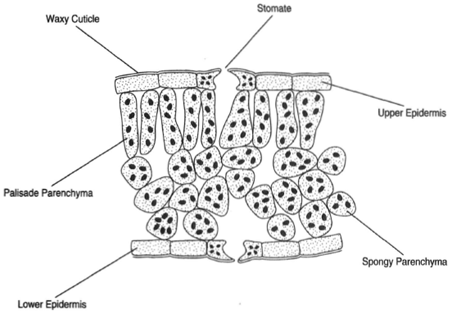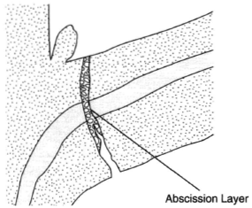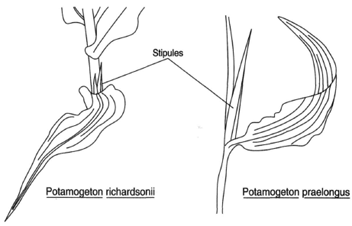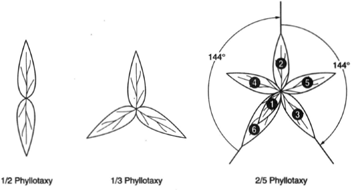Leaves and Plant Classification and Identification
Plants can be classified into two groups according to whether the leaves are shed in the fall (deciduous) or retained through the winter (evergreen). While angiosperms are mostly deciduous and gymnosperms are mostly evergreen, there are some exceptions.What causes leaves to fall in autumn? While it might be supposed that diminishing temperature is the cause, the true cause is diminishing number of daylight hours. As the days grow shorter (and the number of hours of light thus decreases) a zone of corky cells, called the abscission layer, forms at the base of the petiole, figure 34-6. This layer becomes differentiated into a protective layer on the side toward the stem and as separation layer. At the latter region, the cells are weak, and the leaves break away from the tree when the wind blows.
While common leaf characters do not necessarily imply kinship among plants, leaf traits are nevertheless valuable in plant identification. Figure 34-7 shows variations in leaf shape; the names shown apply to the patterns.
Stipules may be present or absent (estipulate). The venation of leaves is important in identification. As stated earlier, monocots generally exhibit parallel venation, and dicots generally exhibit net venation, although there are exceptions. The vestiture (presence of hairs) is also valuablein identification, and there is great variety in vestiture. In fact, approximately forty different terms exist to describe leaf hairs. The margins of leaves are significant, as is leaf arrangement on the stem. The latter may be opposite (alternate) or whorled.
 |
| Figure 34-5 Cross section of a leaf. Stomates appear on both upper and lower surfaces. |
 |
| Figure 34-6 Lanceolate Abscission layer (corky cells that contribute to leaf fall) at the base of a petiole. |
The name given to the arrangement of the leaves on a stem with regard to their relation to one another is phyllotaxy. If a stem bearing leaves is viewed from above so that the distance between leaves can be ignored, it may be noted that the arc from one leaf base to the next is commonly a definite fraction of the circumference. At left in figure 34-9, the arc is ½, that is, ½ of 360°. At center, the arc is 1/3, there being a 120° turn from one leaf base to the next below it. A phyllotaxy of 2/5 means that one can trace two full turns around the stem (the numerator) to come to another leaf in the same position, and in doing so pass through five leaves( the denominator). At right in figure 34-9, the arc between two successive leaves is 2/5 × 360 = 144°.
The phyllotaxy of a plant takes the form of a definite series: for example, ½, 1/3, 2/5, 3/8. In each series, the numerator is the sum of the numerators of the preceding two, and the denominator is the sum of the denominators of the preceding two. Such a series of numbers is called the Fibonacci series after Leonardo Fibonacci (1170-1230)3, an outstanding mathematician of the Middle Ages. It is postulated that leaf arrangement is related to hormone distribution, though the cause of the geometry is unknown.
 |
| Figure 34-8 Leaves with stipules (appendages at the base of a leaf). Both are from aquatic plants: (a) Potamogaton richardsonii, with stipules reduced to shreds, and (b) Potamogeton praelongus, with a long, persistent stipule. |
 |
| Figure 34-9 Phyllotaxy: at left, ½ phyllotaxy; at center, 1/3 phyllotaxy; and at right, 2/5 phyllotaxy. Note that the leaves are numbered. If you trace from leaf 1 to leaf 2, it measures 144°; from leaf 2 to leaf 3 also measures 144°. If you continue to leaf 6 , you will have traced two full passes around to reach the position of beginning at leaf 6 , and you will have passed through five leaves. This is 2/5 phyllotaxy |




